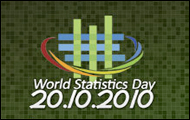
What do a bunch of statisticians do to celebrate World Statistics Day? As Bob Groves, director of the Census Bureau, said, "there probably won't be a parade down Independence Avenue."
But there were lots of meetings around the world, plenty of press releases, and in some cases releases of new statistics on 20.10.2010, the day designated by the United Nations to "raise awareness of the many achievements of official statistics premised on the core values of service, professionalism and integrity."
Complete With a Data Jingle
In Washington, DC, most of the heads of the federal statistical agencies were on hand at a celebration at the Rayburn House Office Building. Remarks were short but informative, leaving plenty of time for networking and conversation. One highlight: Six high school students from Bethesda Chevy-Chase High School in suburban Maryland, making the rounds to meet some of the top statisticians in the U.S.
In other parts of the world, statistics superstar Hans Rosling spoke at an event in Palestine, the Statistical Society of Canada produced a video lamenting the cancellation of the long form census in Canada this year, and the Statistics Department at Carnegie Mellon University created a human histogram of heights on the CMU football field. The Federal Statistical Office of Switzerland marked its 150 anniversary, while in Britain, the Royal Statistical Society launched a ten-year statistical literacy campaign called getstats. The National Statistical Office of Papua New Guinea commissioned a pop jingle (sample lyric: It's a rightful day, to celebrate the many achievements of official statistics).
Digital World's Impact on Data Collection
Speakers at the U.S. celebration included Kathy Wallman, chief statistician of the U.S., Ken Prewitt, Carnegie Professor of Public Affairs and vice president for Global Centers at Columbia University and director of the U.S. Census Bureau during the 2000 decennial census (and a State of the USA board member), Groves and Steve Landefeld, director of the Bureau of Economic Analysis.
Prewitt's talk emphasized the benefits of federal statistics over the increasing tide of data coming from online activity, which he summed up as "privacy, quality, and representation." Federal data collection, by law, takes great pains to assure individual privacy; much effort is expended making sure the data gathered meet quality standards, and the selection process insures a representative sample of the whole country, not just those with computers. The September volume of the Annals of the American Academy of Political and Social Science, which Prewitt guest-edited, is dedicated to the federal statistical system, with 200-plus pages and 22 articles by an array of thought leaders.
Groves spoke about the beauty of probability sampling, which produces statistically valid results while minimizing the burden placed on the public -- the true suppliers of the data. In addition to zealously protecting the privacy of individuals, Groves said, statisticians are obligated to get as much as possible out of the data, in consideration of those who participate.
Landefeld discussed the history of the National Accounts and Gross Domestic Product, which was developed in the 1930s because there was no comprehensive, reliable source of information about the economy to guide policy during the Great Depression. GDP uses data from almost every federal statistical agency and has become a world-wide measure of economic status.
The Federal Statistical System Through History
I picked up armfuls of reports, booklets and computer disks crammed with statistics from the various displays around the room. One interesting chart traces historical events of the federal statistical system from the first decennial census in 1790 to the current day. Among the milestones:
1863: Bureau of Statistics established in the Department of Agriculture
1869: Office of Education established in the Department of the Interior to collect education statistics
1890: Hollerith Tabulator first used to help tabulate results from the census
1902: Permanent U.S. Census Bureau created, and authorized to register births and deaths (now the domain of the National Vital Statistics System within the National Center for Health Statistics, established in 1960)
1934: First official national income estimates are produced (now the responsibility of the Bureau of Economic Analysis)
1940: Sampling first used to ask selected questions in the decennial census
1951: Census Bureau receives the world's first commercial computer, a UNIVAC, build by Remington-Rand and used to tabulate the 1950 census
1977: Energy Information Administration established within the Department of Energy
1979: Bureau of Justice Statistics established under the Justice Systems Improvement Act
2010: Census form has only 10 questions, with decennial long form content collected by the American Community Survey, beginning in 2005.
Scott Gilkeson, chief data officer of State of the USA, is a user experience and data visualization expert with a 20-year history of innovative information delivery.
 Print This
Print This RSS Feed
RSS Feed